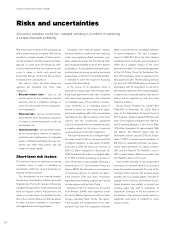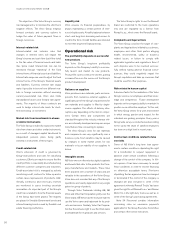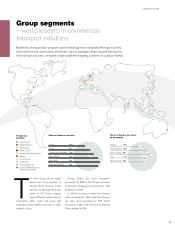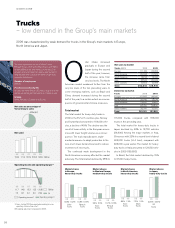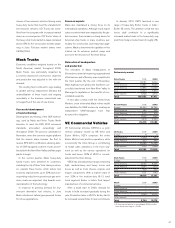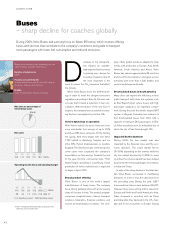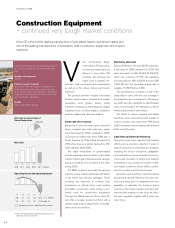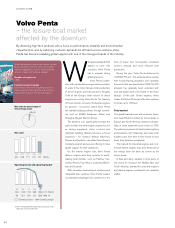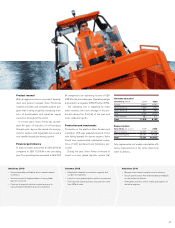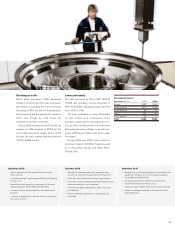Volvo 2009 Annual Report Download - page 46
Download and view the complete annual report
Please find page 46 of the 2009 Volvo annual report below. You can navigate through the pages in the report by either clicking on the pages listed below, or by using the keyword search tool below to find specific information within the annual report.
SEGMENTS 2009
During 2009, Volvo Buses had a strong focus on Green Efciency, which involves offering
buses and services that contribute to the company’s customers being able to transport
more passengers with lower fuel consumption and reduced emissions.
Buses
– sharp decline for coaches globally
emands on the transporta-
tion industry for substan-
tially improved fuel economy
is growing ever stronger for
a number of reasons. One of
the most important is the
need to reduce the CO2 emissions that affect
the climate.
When Volvo Buses chose the SCR-technol-
ogy in order to meet the stringent emissions
regulations according to Euro IV, the main rea-
son was that it meant a reduction in fuel con-
sumption. With the launch of the new Euro V
engines, the company has succeeded in reduc-
ing the fuel consumption by a further 5%.
Volvo’s hybrid bus in operation
With Volvo’s hybrid city buses there are even
more substantial fuel savings of up to 30%
and thus, 30% lower emissions of CO2. During
the spring, eld tests began with one Volvo
7700 Hybrid in Göteborg, Sweden and six
Volvo B5L Hybrid doubledeckers in London,
England. The eld tests have conrmed and in
some cases even surpassed the company’s
expectations on fuel savings. Towards the end
of the year, the rst commercial Volvo 7700
Hybrid began operating in Luxemburg. Serial
production of Volvo’s hybrid buses is expected
to begin in April, 2010.
Broad product offering
Volvo Buses is one of the world’s largest
manu facturers of heavy buses. The company
has a strong, global position with an increasing
share of its sales in Asia. The product program
comprises complete buses, chassis, transport
solutions, telematics, nancial solutions and
service and maintenance contracts. The com-
pany offers global products adapted to local
needs, with production in Europe, Asia, North
America, South America and Africa. Volvo
Buses has sales in approximately 85 countries
and one of the bus industry’s strongest service
networks with more than 1,500 dealers and
service workshops world-wide.
Bi-articulated buses in South America
Many cities can improve the efciency in their
public transport with clever bus systems, such
as Bus Rapid Transit, where buses with high
passenger capacity is an important compo-
nent. During the year, the world’s largest BRT
system in Bogota, Colombia has ordered its
rst bi-articulated buses from Volvo with a
capacity to transport 240 passengers. In Bra-
zil, Volvo launched a new, bi-articulated bus of
which the city of Sao Paulo bought 100.
Impacted by the downturn
During 2009, the bus market was also
impacted by the nancial crisis and the eco-
nomic downturn. The coach market fell by
35–60%, depending on the market, while the
city bus market declined by 0–25%. In some
countries the city bus market has been helped
by government stimulus packages, for instance,
in India and China.
In spite of the sharp decline in the total mar-
ket, Volvo Buses succeeded in maintaining
deliveries on, more or less, the same level as in
the preceding year. During the year, 9,857
buses and bus chassis were delivered (9,937).
However, there was a strong shift in sales from
Europe and North and South America to Asia.
Sales increased in countries such as China
and India while they declined in the U.S., Can-
ada and in most countries in Europe. During
D
8% (6)
Net sales as percentage of
Volvo Group sales
1) Years starting 2006 are reported according to a new
reporting structure. See note 7.
Buses has a product range comprising city and
intercity buses, coaches and chassis.
Number of employees
8,095
Position on world market
The business area is one of the world’s largest
producers of buses and coaches.
Brands
Volvo, Prevost, Nova, Sunwin and Silver.
0908070605
(350) SEK M
%
(76) 231745470
(1.9)(0.4)1.44.32.8
Operating income
1
Operating margin
1
Operating income (loss) and operating margin1
0908070605
18.5 SEK bn17.316.617.316.6
Net sales1
42




